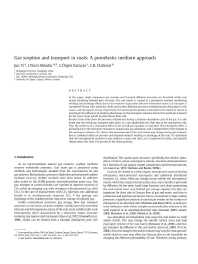Mining Publication: Gas Sorption and Transport in Coals: A Poroelastic Medium Approach
Original creation date: January 2009
In this paper, single-component gas sorption and transient diffusion processes are described within coal matrix exhibiting bimodal pore structure. The coal matrix is treated as a poroelastic medium manifesting swelling and shrinkage effects due to the sorption of gas under effective overburden stress. Gas transport is considered Fickian with molecular (bulk) and surface diffusion processes simultaneously taking place in the macro- and micropores of coal, respectively. The numerical formulation is intended to be explicit in nature to investigate the influences of sorption phenomena on the macropore volumes and on the overall gas transport for the cases of gas uptake by and release from coal. Results of the study show the presence of hysteresis during a sorption-desorption cycle of the gas. It is also found that the overall gas transport takes place at a rate significantly less than that in the macropores only. Thus the existence of a retardation effect in the overall gas transport is concluded. This retardation effect is primarily due to the micropore resistances, in particular gas adsorption, and is independent of the changes in the macropore volumes. It is shown that macroporosity of the coal matrix may change during gas transport due to combined effects of pressure and sorption-induced swelling or shrinkage of the coal. It is estimated that the macroporosity variation is non-uniform in space and time, as it is expected in reality, and typically taking values less than ±10 percent of the initial porosity.
Authors: J Yi, IY Akkutlu, CÖ Karacan, CR Clarkson
Peer Reviewed Journal Article - January 2009
NIOSHTIC2 Number: 20034845
Int J Coal Geol 2009 Jan; 77(1-2):137-144
See Also
- The Composition of Coalbed Gas
- Effect of Coal Type and Oxyfuel Combustion Parameters on Pulverised Fuel Ignition
- Geology and Gas Content of Coalbeds in Vicinity of Bureau of Mines, Bruceton, Pa.
- The Limiting Oxygen Concentration and Flammability Limits of Gases and Gas Mixtures
- Methane Diffusion Parameters for Sized Coal Particles: A Measuring Apparatus and Some Preliminary Results
- Methane Emissions from Gassy Coals in Storage Silos
- The Modified Direct Method: A Solution for Obtaining Accurate Coal Desorption Measurements
- Reconciling Longwall Gob Gas Reservoirs and Venthole Production Performances Using Multiple Rate Drawdown Well Test Analysis
- Reducing Hazards in Underground Coal Mines Through the Recognition and Delineation of Coalbed Discontinuities Caused by Ancient Channel Processes
- Reservoir Engineering Considerations for Coal Seam Degasification and Methane Control in Underground Mines
- Content source: National Institute for Occupational Safety and Health, Mining Program


 ShareCompartir
ShareCompartir
